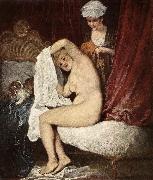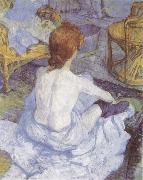Wholesale Oil Painting No Minimum |
|||||||||||
|
|
|||||||||||

|
|||||||||||
|
|
|
||||||||
WATTEAU, Antoine(1684?C1721). French painter of Flemish descent, b. Valenciennes. Until 1704 poverty forced him to work in the shops of mediocre artists, where he produced genre and devotional subjects. In 1704?C8 he studied in the studio of Claude Gillot, an adept painter of scenes of theatrical life, which later became the subject of some of Watteau's finest paintings, such as Love in the Italian Theatre and Love in the French Theatre (both: Berlin). In 1708?C9 Watteau worked with the decorator Claude Audran. Watteau attracted the attention of eminent patrons in his last years, including the comte de Caylus, his biographer, and in 1717 he was made a full member of the Acad??mie royale. The Embarkation for Cythera (1717; Louvre) is characteristic of his art; it is a delicate, courtly fantasy, represented in warm and shimmering pastel tones that place him among the great colorists of all time. A lyric, Giorgionesque quality pervades his airy, gay, and sensuous scenes, which have a poignancy that none of his followers attained. Out of the most fleeting aspects of life he created an enduring and individual art. His exquisite paintings influenced fashion and garden design in the 18th cent. Other outstanding works include Gilles (Louvre), Perspective (Mus. of Fine Arts, Boston), Mezzetin (Metropolitan Mus.), and Gersaint's Shop Sign (1719; Berlin). |
||||||||
|
|
||||||||
The Toilette
The Toilette Painting ID:: 7153 |
Oil on canvas
Wallace Collection, London Oil on canvas Wallace Collection, London |
|||||||
|
|
||||||||
Henri de toulouse-lautrec1864-1901 French painter and printmaker. He is best known for his portrayals of late 19th-century Parisian life, particularly working-class, cabaret, circus, nightclub and brothel scenes. He was admired then as he is today for his unsentimental evocations of personalities and social mores. While he belonged to no theoretical school, he is sometimes classified as Post-Impressionist. His greatest contemporary impact was his series of 30 posters (1891-1901), |
||||||||
|
|
||||||||
|
|
The Toilette
The Toilette Painting ID:: 33994 |
mk87
1896
Oil on cardboard
67x54cm
Paris,Musee d'Orsay
mk87 1896 Oil on cardboard 67x54cm Paris,Musee d'Orsay |
||||||
|
|
||||||||
|
Henri de toulouse-lautrec 1864-1901 French painter and printmaker. He is best known for his portrayals of late 19th-century Parisian life, particularly working-class, cabaret, circus, nightclub and brothel scenes. He was admired then as he is today for his unsentimental evocations of personalities and social mores. While he belonged to no theoretical school, he is sometimes classified as Post-Impressionist. His greatest contemporary impact was his series of 30 posters (1891-1901), The Toilette mk87 1896 Oil on cardboard 67x54cm Paris,Musee d'Orsay |
||||||||
|
|
||||||||
|
Prev Next
|
||||||||
|
|
||||||||
|
Related Paintings to Henri de toulouse-lautrec :. |
||||||||
|
|
||||||||
|
CONTACT US |


